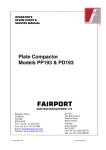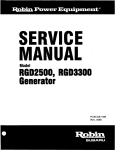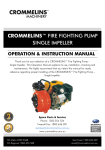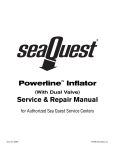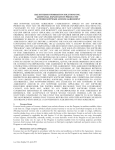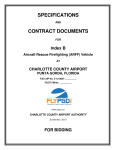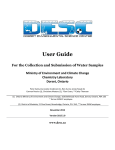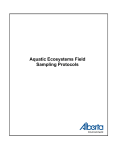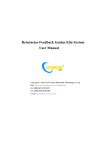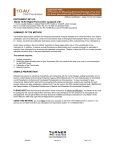Download User Manual Table of Contents - Wolf-Air
Transcript
Wolf air compressors PO Box 783 Port Lincoln SA 5606 Ph: 08 8682 1540 fax: 08 8682 4736 e-mail: [email protected] User Manual Table of Contents 1.1 1.2 1.3 1.4 General safety precautions Operation precautions Maintenance & repair precautions Installation precautions 2 2.1 2.2 2.3 General information Introduction Design & purpose Mode of operation 3 3.1 Delivery & installation Post delivery of compressor 4 4.1 4.2 4.3 4.4 Operation pre start up Location of compressor Compressor Electric motor Combustion engine 5 Start up 6 Running compressor 7 Shut down 8 8.1 8.2 8.3 inspection / maintenance timetable Introduction General Inspection / maintenance timetable 9 9.1 9.2 9.3 9.4 9.5 9.6 Preventative maintenance Oil change Filter change Pressure vessel maintenance Cleaning compressor Drive belt Compressor log sheet 1.1 - General safety information Most accidents which occur during the operation and maintenance of machinery are a result of failure to observe basic safety rules or precautions. Recognising a situation that is potentially hazardous can often prevent an accident. Wolf Air Compressors Pty Ltd cannot anticipate every possible circumstance, which might represent a potential hazard. The warnings in this manual are therefore not all inclusive. If the user employs an operating procedure, for an item of equipment or a method of working which is not specifically recommended by Wolf Air Compressors Pty Ltd then they must ensure that the unit will not be damaged or made unsafe and that there is no risk to persons or property. Failure to observe these precautions given under “safety precautions” may be considered dangerous practise or misuse of the compressor Read and understand all warning, caution and mandatory labels on the unit before operating or carrying out maintenance or servicing. Warnings call for attention to operation procedures involving specific hazards, which could cause injury or death and are identified by the following: Before releasing compressed air through a hose make sure the free end is held securely so that it can not whip and cause injury. Prior to starting their job and periodically in reasonable intervals, however at least once a year, operating personnel are to be instructed regarding the following subjects: • • • • • The particular hazards involved in handling compressed gases Safety regulations What to do in case of fault, damage and accident How to use fire extinguishers and other safety equipment Operating and maintenance of the filling system according to the instruction manual To prevent fire hazard and to provide adequate ventilation, keep the engine at least 1 metre (3feet) away from buildings and other equipment during operation. Do not place flammable objects close to that engine Do not smoke or allow flames or sparks where the engine is refuelled or where fuel is stored. 1.2 - Operating precautions Competent personnel under a qualified supervisor must only operate the compressor. Do not operate the compressor with any removable inspection cover removed e.g. crankcase, doors, valve covers, etc. Never remove or tamper with safety devices, guards or insulation materials. The compressor must only be operated at the supply voltage and frequency for which it is designed. Always isolate power before maintenance or servicing. When mains power is on, lethal voltages are present in the electrical circuits and extreme caution is needed when essential work is carried out on the electrical system. Always consult a qualified electrician before any such essential work. Do not open starter compartment to touch electrical components while voltage is applied unless it is necessary for measurement, test or adjustment. A qualified electrician with appropriate tools and protection against an electrical hazard should always carry out such work. Always make a pre-operation inspection before you start the engine. You may prevent an accident or equipment damage. Know how to stop the engine quickly, and understand the operation of all controls. Never permit anyone to operate the engine without proper instructions. Do not place flammable objects such as fuel, matches, etc. Close to the engine while it is running. Exhaust gas contains poisonous carbon monoxide. Avoid inhalation of exhaust gases. Never run the engine in a closed garage or confined area. Place the engine on a stable surface. Do not tilt the engine more than 20 degrees from horizontal. Operating at excessive angles may result in internal damage. Do not place anything on the engine, as it may create a fire hazard A spark arrester is available as an optional part of this engine. It is illegal in some areas to operate an engine without a spark arrester. Check local laws and regulations before operating. The muffler becomes very hot during operation and remains hot for a while after stoping the engine. Be careful not to touch the muffler while it is hot. To avoid severe burns or fire hazards, let the engine cool before transporting it or storing it indoors. Do not operate the unit when guards provided for protection for all rotating and reciprocating parts have been removed for essential maintenance. Secure guards following any servicing or repair. Local noise regulations must be observed. Noise at work regulations 1989 suggest ear defenders when the level is greater then 85 db at one meter. Be aware, high noise levels can interfere with communication. Ensure intake air is free from noxious gas, exhaust fumes and solvent vapour. Use an intake hose and ensure that it is mounted in such a way as to avoid taking in any noxious substances. 1.3 - Maintenance & repair precautions When handling, operating or carrying out maintenance on the unit, personnel must observe safe engineering practices and all relevant local regulations. The attention of users is drawn to the Health and Safety at Work Act 1974, and the regulations of the Institute of Electrical Engineers. When using cleaning solvents, local health and safety regulations must be complied with. Provide good ventilation and use suitable protection such as a breathing filter mask, safety glasses, protective apron and gloves. Refuel in a well-ventilated area with the engine stopped. fuel is highly flammable and explosive under certain conditions. Do not overfill the fuel tank. There should be no fuel in the filler neck. Make sure that the filler cap is closed securely. If any fuel is spilled, clean it up completely and allow petroleum vapours to dissipate before starting the engine. Make sure all instruction concerning operation and maintenance are strictly followed and that the complete unit, with all accessories and safety devices, is kept in good order. The accuracy of pressure gauges and temperature switches should be regularly checked at least 3 month intervals and thoroughly examined at least every 12 months. They must be renewed or serviced when acceptable tolerances are exceeded. Protection devices should be tested at each regular service interval and replaced, serviced or exchanged if not functioning correctly. The maximum pressure for safety valves under fault conditions is 1.10 times the set pressure, the set pressure being a minimum of 1.05 times the maximum operating pressure to ensure seat tightness. Before dismantling any part of the compressor, be sure that all heavy movable parts are secure. After completion of any maintenance or repair ensure that no tools, loose items or rags are left on or inside the compressor. Do not use any flammable liquid to clean valves, filter element, cooler passages, pipe bores or any component carrying a flow of air or gas during normal operation. If chlorinated hydrocarbon substances are used for cleaning, safety precautions must be taken against toxic vapours, which may be released. Precaution must be taken against using acid, alkalis and chemical detergents for cleaning machined parts. These materials cause irritation and are corrosive to the skin, eyes, nose and throat. Avoid splashes and wear suitable protective clothing and safety glasses. Do not breathe mists. Ensure water and soap is readily available. When disposing of condensate, used oil, used filters elements and other parts and waste material of any kind make sure that there is no pollution to any drain or natural water course and that no burning of waste takes place which could cause pollution of the atmosphere. Keep the compressor clean at all times. Protect components and exposed openings by covering with a clean cloth or tape during repair or maintenance work. Protect the motor, intake, electrical and regulation components against the entry of moisture eg steam cleaning. Condensation oil and water mixture from the compression process must be regarded as trade effluent and is therefore not suitable for discharges into a surface water sewer, soakaway or watercourse. Competent persons under a qualified supervisor must carry out maintenance repair and modifications. Always shut down and decompress the complete system prior to carrying out any work on the compressor. Working on compressor unit requires the necessary expert knowledge. Check the complete system for leakage from time to time by brushing all fittings and couplings with soap water or spraying with leak test spray. Repair any leakage immediately. Always disconnect the system from mains supply prior to carrying out any work on the compressor system with electric drive motor. Do not use toxic substances like fuel or acetone or similar to clean the compressor unit or any of its parts. 1.4 - Installation precautions A power isolator switch must be fitted between the main power supply and the compressor. Precautions must be taken to ensure that no injury is caused to passes-by. A manual shut-off valve should be fitted in the discharge line to allow the compressor to be isolated. Non return valves cannot be relied upon for isolating parts from a pressure system. Safety valve must be installed between any compressor unit and the isolating valve. A pressure-reliving device must be fitted to every pressure vessel, or equipment containing air or gas above atmospheric pressure. Never remove or tamper with safety devices or guards. Children and pets must be kept away from the area of operation due to a possibility of burns from hot engine components or injury from moving parts to the worker or any equipment. 2.2 - Design and purpose The Wolf Air compressor is designed to provide breathable low pressure air for the purpose of diving and confined spaces use. The basic principles of a Wolf Air compressor is to take clean atmospheric air and compress the air via a reciprocating compressor (single or two stage method). Then cooling and storing the air under pressure via a pressure vessel, which is maintained by the over pressure maintaining valve, the air is then delivered to the filtration part of the compressor where it is filtered and pressure is monitored for delivery and use. 2.3 - Mode of operation The air is drawn through the intake filter, compresses in pump cylinders, then sent through non return valve to air receiver were oil/water condensate and can be drained off. Overpressure relief valve on receiver to maintain pressure (set8 bar) air then enter pre-filter (water/oil separator) and pressure reading then enter activated carbon (purified) then out to application. (see following 7 images showing air flow direction) Image 1 Image 2 Image 3 Image 4 Image 5 Image 6 Image 7 3 - Delivery Installation Unpack the unit from transport packaging and place on level ground or surface. Check lubricant levels in motor and compressor unit. If these levels are low it could mean that the unit was not transported correctly and a number of things need to be checked. If so check the cardboard transport carton for signs of oil leakage. If there are signs that there has been oil leaking out of the unit, contact Wolf Air compressors for further instruction on (08) 8682 1540. If the unit is run and damage results from lack of oil, your warranty will be void. Please note if the unit has been transported by airfreight, there will be no lubricating oil in the motor of the compressor. Do not run the unit until these oils have been replaced. Check to be sure that the fuel you intend to use for the Honda petrol powered unit is clean and fresh unleaded petrol (for uses with dy27 diesel powered units, use only clean fresh diesel fuel) Give the compressor unit a general all over inspection and if it is damaged in any way, notify Wolf Air compressors immediately on the above number. 3.1 - Post delivery When you first receive your Wolf Air compressor carefully unpack it and examine it for any damage that may have occurred during shipment Use the packing slip provided to ensure that no damaged or missing parts. Be sure to fill out the enclosed warranty card and return to Wolf Air compressors. No warranty claims will be honoured with out a completed warranty card on file at Wolf Air compressors. The outlet side of filter assembly is plugged and must be connected 1 2 3 Remove plug The connection on filters is 1/4bspt It is best to install a lock off fitting as per as2299 i.e. tema. Att: it is important that locking fittings are installed to keep contaminates out of the filter system and to keep filter assembly airtight. 4 – Pre-start up of compressor Location / installation of compressor The compressor must be placed on a flat stable surface and where air can flow freely around the unit to allow sufficient cooling (allow at least 1 metre of clearance around compressor) Warning: - do not locate compressor were there are vehicles / plant with running engines in direct vicinity of co2 (carbon monoxide) 4.1 – Pre-start up of compressor Check that the air inlet hose or snorkel is securely attached to the unit and that the inlet is upwind of the exhaust to prevent noxious exhaust fumes being drawn into the compressor. It is good practice to have the inlet hose at least 2 metres in length above ground Att: monitor compressor at all times during use. Move compressor if wind direction changes Warning: Do NOT run petrol and diesel driven compressors indoors. If running electric compressor inside, ensure there is adequate ventilation around the compressor Warning: - co2 ATTENTION Operators are urged to familiarise themselves with AS/NZS 2299.1:1999 (Occupational diving operations - Standard operational practice) - specifically 5.7 (c, d, e, and f) Due to commerciality of the standard, we are unable to provide this information to you. You can purchase AS/NZS 2299.1 online at http://www.saiglobal.com 4.2 - Compressor Prior to each start up, the lubricant levels needs to be checked, the compressor level via the centre mark on the sight glass if low top up with recommended oil (Castrol sn68 or sn100) Connect and secure low pressure line to outlet of compressor. Att: - only use proper air breathing hose that is AS2299 compliant ATTENTION Operators are urged to familiarise themselves with AS/NZS 2299.1:1999 (Occupational diving operations - Standard operational practice) - specifically 5.7.5 Do not run outlet hose over the top of the compressor If the air supply is run from the compressor unit through a distribution panel ensure all correct procedures are followed and check the correct operation of the complete system prior to use. If the compressor is new or has not been used for a long time it should be turned over by hand if the compressor does not rotate it should be checked and serviced. 4.3 - Electric motor If the compressor is the electric motor version make sure that the main power supply characteristics correspond to the data shown on electric motor and in particular: • • • • Type of power supply The voltage The frequency The power If the electric motor is three phase check that the direction of rotation is correct (fan must direct the air flow towards the compressor) Place a main switch with suitably rated fuses in the line from your electrical system to the motor 4.4 - Combustion engine Prior to starting engine. Please read through appropriate engine owner manual. 1 2 Check direction of use and maintenance handbook before start up Before running, fill the engine fuel tank with appropriate fuel while engine is cold. Att: never fill with fuel while unit is running. 3 Check oil level Att: there is an oil alert system on engine. The oil alert system is designed to prevent engine damage caused by low level of oil. If the engine stops and will not restart, check the engine oil level. 5 - Staring compressor Before starting compressor, make sure that both condensation drains are open so that motor starts without load When starting petrol driven compressor have one person holding compressor while it is pull started Start compressor Electric Note: Check direction on three phase engines Petrol Att: Read starting engine procedure on petrol engines section and owners manual (run and approx 1/3 throttle) Diesel Att: Read starting engine procedures. Run the machine for 2-3 minutes with the drains open before bringing it up to load Close condensation drains Att: check to be sure the unit is building up to the appropriate pressure. A final check on air supply hoses and connection to be sure there are no leaks 6 - Running compressor During operation of the compressor unit the condensation drains need to be opened momentarily, every ½ hour or so to drain off accumulated water from pressure vessel. Note the amount of condensation which collects, depends solely on the percentage of humidity in the atmosphere The compressor unit must be monitored at all times by a qualified person. The person must monitor • • • • Gauge pressure Wind direction / air intake Fuel level Hose connections 7 - Shutting down compressor Warning-ensure all personnel are disconnected from compressor before shutting down Slowly open drain and filter valves and allow compressor to drop in pressure Petrol / diesel engines Slow petrol engine and let idle for a few minutes Turn the engine switch to the off position Turn the fuel valve to the off position Electric Let compressor run for a few minutes Push red off button on electric motor then turn off at main switch Then close valves again, so that moisture cannot enter the unit. Check oil on compressor and engine Record hours run and date to establish next service time. 8 - Inspection / maintenance table Each use daily • Check oil levels • Check for air leaks • Check fittings • Check for unusual noise or vibration • Drain condensation from pressure vessel Weekly / 10 hours • Check air inlet filter • Clean all external parts of compressor • Check work pressure of compressor Monthly / 25 hours • Inspect the entire air system for leaks • Inspect condition of oil and change if necessary • Check drive belt tension and tighten if needed Every 3 months / 100 hours • Change air inlet filter • Air test / filter change • Check O-ring on filter housing Every 6 months / 200 hours • Check non return valve • Change oil • Inspect valves clean if necessary • Check pressure gauge for accuracy (calibration maybe necessary) • Replace pre filter element (replace o-ring on filter) Every 12 months / 400 hours • Change valves • Pressure test vessel (1.5 times working pressure) • Replace non return vale • Replace oprv • Check / replace rubber mounts • Check / replace guards • Check / replace drain valve • Check / replace manifolds and piping • Clean pressure vessel 8.1 - Intro maintenance schedule This section covers the preventative maintenance necessary on the compressor, a compressor that is kept clean and in good repair will offer far better service to the user. 8.2 - General Personnel must follow the minimum standard for the care and maintenance of the compressor. The maintenance timetable is supplied with recommendation. Here with the suggestions, the operator must establish whatever additional service is necessary to provide a good working unit. Using the compressor in a fresh water environment will differ from a compressor in salt water environment. Using the compressor in salt water environment and high humidity condition will require more frequency in servicing. 9.1 - Preventative maintenance Oil changes 1 2 Motor- initial change is at 10 hours and subsequent changes should be completed every 50 hours in severe operating conditions or every 100 hours in ideal operating conditions. Check dipstick for correct level. Compressor – initial change is at 10 hours. Second change 50 hours and subsequent changes at 100 hours. Check sight glass for correct level. 9.2 - Preventative maintenance Filter changes 1 2 Filters should be changed initially at 10 hours. Second and subsequent changes should occur at 20-30 hour intervals under ideal conditions. At no time should changes occur at intervals greater then 50 hours. In severe operating conditions, i.e. very high humidity, more frequent changes are required. Festo water trap should be cleaned at the same time as the filters are changed. Refer to Festo information sheet supplied with this manual 9.3 - Preventative maintenance Pressure vessel maintenance: 1 2 The pressure vessel should be cleaned out at oil change time. It can be steam cleaned or cleaned using hot water and detergent. This is to prevent a build up of old residues and contaminants on the walls of the vessel After the vessel has been properly cleaned, all external fittings such as drain cocks, pressure relief valve and non-return valve should be checked for correct operation. If they fail to operate or are worn or damaged in any way, they must be replaced before the unit is put back to service. Repairs 1 Repairs: repairs should be carried out only by qualified persons and in the event that the problem is covered by warranty, the work must be carried out by Wolf Air compressors. Failure to meet this requirement will void the warranty. Check air inlet filter Inspect air filter for dirt or dust, a clogged air filter can seriously affect the efficiency of the compressor and cause overheating and oil usage. An oil change will be necessary Inspect condition of oil, change if necessary, if there is a change in colour (white= presence of water / black =to hot) replace it completely. It may be necessary to change the oil more frequently due to the abnormal humid and contaminated conditions. 9.4 - Cleaning compressor Clean all external parts of the compressor Allow unit to cool close all valves and cover inlet. Wash down with fresh water to remove salt deposits Warning: a dirty compressor will cause abnormally high discharge temperature and resulting in oil carbonisation on internal valve components Check:- non-return valves and cam locks are opening and closing and are in good working order Drain condensate from pressure vessel and filter (See Image 8 & 10) Image 8 Image 10 Run compressor for 5-10 minutes with valves open to blow all condensation out of the pressure vessel and filters Check for unusual noises or vibration Run compressor and check that the compressor builds up pressure smoothly and runs at full pressure. Check drive belt tension and tighten if needed 9.5 - Drive belt Insufficient tension causes a reduction in output, vibration, belt slap, and premature wear. Excessive tension causes an increase in the load. The consequence is excessive bearing wear and excessive start up torque. The tension is adjusted through the adjustment bolts on the prime mover. First loosen 4 bolts holding the prime mover to the base plate. Move prime mover via the nuts either back or forward. With right belt tension screw down holding bolts then back of nuts on adjustment bolts.















